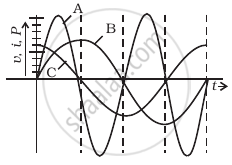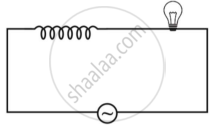Advertisements
Advertisements
Question
Compare resistance and reactance.
Solution
- Resistance:
- Resistance is opposition to the flow of charges (current) and appears in a DC circuit as well as in an AC circuit.
- In a purely resistive circuit, current and voltage are always in phase.
- Resistance does not depend on the frequency of AC.
- Resistance gives rise to the production of Joule heat in a component.
- Reactance:
- The term reactance appears only in an AC circuit. It occurs when an inductor and/or a capacitor are used.
- When reactance is not zero, there is nonzero phase difference between current and voltage.
- Reactance depends on the frequency of AC. In the case of an inductor, reactance increases linearly with frequency. In the case of a capacitor, reactance decreases as the frequency of AC increases; it is inversely proportional to frequency.
- In a circuit with pure reactance, there is no production of heat.
APPEARS IN
RELATED QUESTIONS
A 2 µF capacitor, 100 Ω resistor and 8 H inductor are connected in series with an AC source.
(i) What should be the frequency of the source such that current drawn in the circuit is maximum? What is this frequency called?
(ii) If the peak value of e.m.f. of the source is 200 V, find the maximum current.
(iii) Draw a graph showing variation of amplitude of circuit current with changing frequency of applied voltage in a series LRC circuit for two different values of resistance R1 and R2 (R1 > R2).
(iv) Define the term 'Sharpness of Resonance'. Under what condition, does a circuit become more selective?
A current i1 = i0 sin ωt passes through a resistor of resistance R. How much thermal energy is produced in one time period? A current i2 = −i0 sin ωt passes through the resistor. How much thermal energy is produced in one time period? If i1 and i2 both pass through the resistor simultaneously, how much thermal energy is produced? Is the principle of superposition obeyed in this case?
Is energy produced when a transformer steps up the voltage?
A transformer is designed to convert an AC voltage of 220 V to an AC voltage of 12 V. If the input terminals are connected to a DC voltage of 220 V, the transformer usually burns. Explain.
A capacitor acts as an infinite resistance for ______.
The peak voltage of a 220 V AC source is
An AC source is rated 220 V, 50 Hz. The average voltage is calculated in a time interval of 0.01 s. It
A bulb rated 60 W at 220 V is connected across a household supply of alternating voltage of 220 V. Calculate the maximum instantaneous current through the filament.
A transformer has 50 turns in the primary and 100 in the secondary. If the primary is connected to a 220 V DC supply, what will be the voltage across the secondary?
A device Y is connected across an AC source of emf e = e0 sin ωt. The current through Y is given as i = i0 sin (ωt + π/2).
- Identify the device Y and write the expression for its reactance.
- Draw graphs showing a variation of emf and current with time over one cycle of AC for Y.
- How does the reactance of the device Y vary with the frequency of the AC? Show graphically.
- Draw the phasor diagram for device Y.
Suppose the initial charge on the capacitor is 6 mC. What is the total energy stored in the circuit initially? What is the total energy at later time?
Average power supplied to a capacitor over one complete cycle is ______.
A capacitor has capacitance C and reactance X, if capacitance and frequency become double, then reactance will be ______.
A device ‘X’ is connected to an a.c source. The variation of voltage, current and power in one complete cycle is shown in figure.
- Which curve shows power consumption over a full cycle?
- What is the average power consumption over a cycle?
- Identify the device ‘X’.

Explain why the reactance provided by a capacitor to an alternating current decreases with increasing frequency.
An iron cored coil is connected in series with an electric bulb with an AC source as shown in figure. When iron piece is taken out of the coil, the brightness of the bulb will ______.

A resistor of 50 Ω, a capacitor of `(25/pi)` µF and an inductor of `(4/pi)` H are connected in series across an ac source whose voltage (in volts) is given by V = 70 sin (100 πt). Calculate:
- the net reactance of the circuit
- the impedance of the circuit
- the effective value of current in the circuit.
